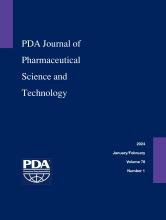Abstract
In the development of a pharmaceutical drug product packaging, an important step is to demonstrate acceptable levels of leachable impurities migrating from the packaging material into the drug product during its shelf life and therapeutic use. Such migration processes can be quantified either by analytical methods (which is often challenging and labor intensive) or (in many cases) through theoretical modeling, which is a reliable, quick, and cost-effective method to forecast the level of leachable impurities in the packaged drug when the diffusion and partition coefficients are known. In the previous part, it was shown how these parameters can be determined experimentally, and subsequent theoretical fitting of the results for a series of low- and high-molecular-weight organic compounds (known leachables) in a series of polyolefin materials was performed. One of the interpretations of these results is that a theoretical calculation can be made only for organic compounds and materials whose diffusion/partition/solubility coefficients were determined experimentally and theoretical fitting was achieved. However, in practice, there will be situations in which other leachable compounds may have to be investigated. In such cases, strictly speaking, it would be necessary to perform the whole experimental and fitting procedure for the new compound before a proper theoretical modeling is possible. But this would make the theoretical calculation of a leaching process from a pharmaceutical packaging material a cumbersome and cost intensive procedure. To address this problem, the pools of diffusion and partition coefficients were used to develop an approach that allows the estimation, without any additional experimentation, of so-called “conservative” diffusion and partition coefficients for a much wider range of potential leachables in the polyolefin pharmaceutical packaging materials and aqueous solutions investigated previously.
- Extractables and Leachables (E&L)
- Pharmaceutical packaging
- Conservative diffusion and partition coefficients
- Predictive modeling
- Migration modeling
- © PDA, Inc. 2024
PDA members receive access to all articles published in the current year and previous volume year. Institutional subscribers received access to all content. Log in below to receive access to this article if you are either of these.
If you are neither or you are a PDA member trying to access an article outside of your membership license, then you must purchase access to this article (below). If you do not have a username or password for JPST, you will be required to create an account prior to purchasing.
Full issue PDFs are for PDA members only.
Note to pda.org users
The PDA and PDA bookstore websites (www.pda.org and www.pda.org/bookstore) are separate websites from the PDA JPST website. When you first join PDA, your initial UserID and Password are sent to HighWirePress to create your PDA JPST account. Subsequent UserrID and Password changes required at the PDA websites will not pass on to PDA JPST and vice versa. If you forget your PDA JPST UserID and/or Password, you can request help to retrieve UserID and reset Password below.






